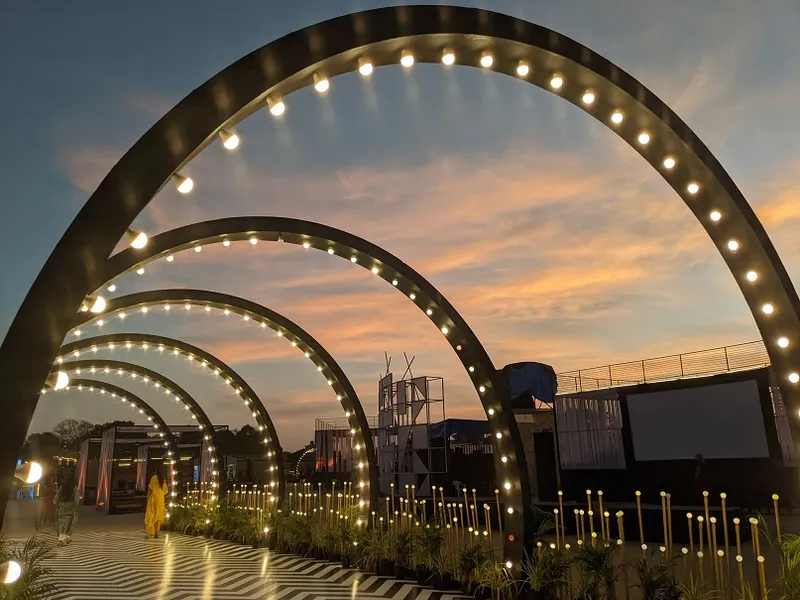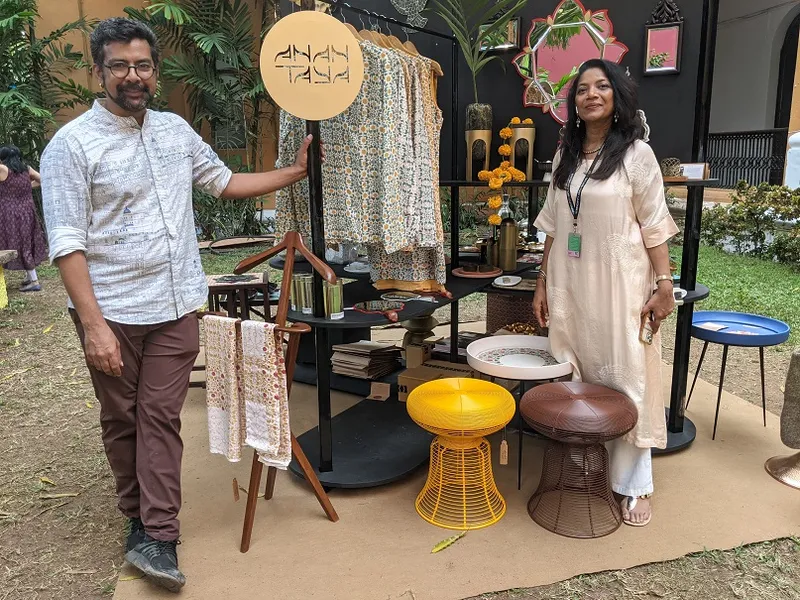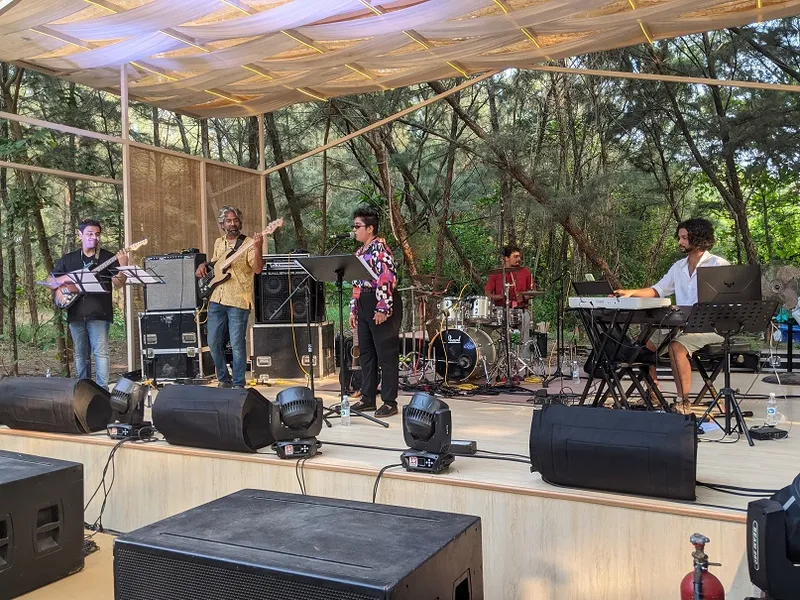Diversity, delight, digital—how the Serendipity Arts Foundation promotes art on a national and international scale
Sunil Kant Munjal, Chairman of Hero Enterprise, and Smriti Rajgarhia, Director of the Serendipity Arts Foundation, join us in this interview on the evolution and impact of SAF 2002.
Launched in 2014, PhotoSparks is a weekly feature from YourStory, with photographs that celebrate the spirit of creativity and innovation. In the earlier 665 posts, we featured an art festival, cartoon gallery. world music festival, telecom expo, millets fair, climate change expo, wildlife conference, startup festival, Diwali rangoli, and jazz festival.
The renowned Serendipity Arts Festival (SAF) wraps up its fifth edition in Goa tomorrow. See our earlier photo essays on the 2022 and 2019 editions here. In this photo essay, we feature more artworks from the festival, along with founder and director insights.

Sunil Kant Munjal, Founder Patron, Serendipity Arts Foundation
Sunil Kant Munjal is one of the founder-promoters of Hero Group, India’s premier automotive manufacturing group. The story of the group is well-captured in his compelling book, The Making of Hero: Four Brothers, Two Wheels and a Revolution that Shaped India (see my book review and author interview).
Sunil chaired the board that runs the Doon School and sits on the boards of IIM Ahmedabad and ISB. He co-founded BML Munjal University (BMU) and served as President of CII. He also set up the Serendipity Arts Foundation to promote art on a national and international scale.
Smriti Rajgarhia is Director of the Serendipity Arts Foundation and the Serendipity Arts Festival. Trained as an architect with a Masters in Design, she has also worked in the museum, archives, and art space. She aims to widen the demographic of the audience for the arts in India, as well as explore urban spaces and art impacts.

Smriti Rajgrahia, Director, Serendipity Arts Foundation & Festival
Sunil and Smriti join us in this interview on the origins and evolution of their festival, trends in the arts space, and messages for audiences and aspiring artists.
Edited excerpts below:
YourStory [YS]: How did SAF evolve during the restrictive phases of the pandemic—and what were some of the lessons learnt?
Sunil Kant Munjal [SKM]: We provided a platform to artists across practices who were affected by the physical disconnect and the digital divide caused by the pandemic. Special efforts were also made to connect artisans to a larger audience through digital initiatives such as SAF x You, and a do-it-yourself How to Series comprising a broad range of workshops on diverse topics for people across skill levels, occupations, and backgrounds.

We also organised Serendipity Arts Virtual, which was a specially curated internet-ready festival that introduced crafts and fringe arts practices to an entirely new audience. It helped artists and artisans regularise their work while establishing a market base. This digital outreach helped us reach out to more than 42 million people across the globe, as per Google Analytics.
The pandemic marked an important watershed in our evolution; it taught us how to look at constraints through the prism of opportunity. It also taught us that even in difficult times, the arts could make a difference in the lives of people.
The pandemic showed us the world of digital possibilities. In the fifth physical edition of the Serendipity Arts Festival, we are integrating the digital and the physical to make the arts more participatory, engaging, immersive, and interdisciplinary.

[YS]: What are the unique strengths of Indian art and heritage, and how can they be promoted in a more meaningful manner?
[SKM]: Diversity is the first major strength. Our languages, music, theatre, dances, literature, and culinary arts have evolved over several millennia and are the outcome of many different influences.
These influences have led to multiple layers of cultural expressions, traditions, and arts practices that are distinct and differentiated. In fact, even ostensibly similar practices are often observed differently across regions and communities.
The Serendipity Arts Festival is our way of celebrating—and where required—contemporising this cultural richness through national and international platforms.

Adaptability is the second strength of our arts and culture. Unlike many Western classical forms that are stringent with less scope for improvisation and accommodating cross-disciplinary accents, Indian art forms can absorb multiple cultural accents and yet remain distinctively Indian.
Examples of this adaptability are seen across our architecture, music, poetry, and food. Through our foundation’s various activities as well as the festival, we showcase and celebrate this adaptive spirit.
The third strength of our arts and culture lies in its durability. Good examples of this are our dohas, couplets and hymns that chronicle our shared histories, cultures, and values that are passed from generation to generation. Through the Foundation, we are preserving and reviving some of the art practices that have symbolised this country across centuries.
As India emerges as a strong economic engine, it is important to ensure that our cultural essence and vitality don’t get lost—and we are doing what we can to ensure this.

[YS]: You have an interesting range of partners this year—what will Microsoft add as a partner?
Smriti Rajgarhia [SR]: We are fortunate to have the support of individuals and entities, not only for this edition, but for all the previous editions.
As our technology partner for our 2022 edition, Microsoft brings a much-needed emphasis on how technology can aid access to the arts.
Its devices will be powering a range of our workshops, especially in our accessibility programming, ensuring that children with special needs can bring their creativity and enthusiasm to the forefront.

[YS]: Volunteers are an important part of the festival - how many are there this year, and how have they been selected?
[SR]: Volunteers are a very strong support system for the festival and an extension of our core team. We have had a really talented pool of volunteers in the past, some of whom have even joined our core team, across departments.
Our social media was flooded with messages from youngsters all over the nation once we announced that we are back with our physical edition. Beyond online applications, we have also partnered with schools and colleges from across the nation, and Goa for volunteers.
Our volunteer strength this year has gone over 300.

[YS]: How does the 5th edition of the festival differ from earlier editions?
[SR]: The art, the approach and the energy are different for each edition, and more so this year after a hiatus of two years. More than a theme, the festival is based on a broad set of ideals like experimentation, access to the arts, interdisciplinarity, and sustainability. We create a mandate with these broad areas, more to lay down the foundation for the programming.
What eventually gets highlighted varies year on year depending on the current world views, as well as an organic and serendipitous coming together of curators, artists and programming! As an institution, we have been looking at breaking away from the idea of limiting conversations within the discipline, and encouraging conversations between different genres of the arts, and mediums such that we can expand the canvas for the arts ecosystem.
For us, the festival is a space where we have been able to try new kinds of programming, see new themes emerge every year, and see how creative placemaking can impact a space.

[YS]: What is your message to aspiring artists?
[SKM]: If you visit an Indian home, chances are that you will find one or more family members practicing some form of art, varying from visual, aural, literary to culinary. Until recently, these were at best merely hobbies, not career pursuits.
Now, spaces are emerging which accommodate and promote a diverse range of cultural and artistic practices both in their pure and crossover forms. I believe the foundations are in place to build a very strong cultural economy where thousands of jobs can emerge, both permanent and contractual.
So, my message to aspiring artists is to continue pursuing their arts practices sincerely and pragmatically. They should look for good guidance while also finding innovative ways to collaborate with other artists – this will help them strengthen their offerings.

[YS]: What is your message to the audience?
[SR]: We have put together an engaging and immersive programme with some of the best artistic minds from across the country and the world, to ensure that we surprise and hopefully delight you with every walk-in.
So do come and experience the magic of the arts with your family, friends, and us!
Now, what have you done today to pause in your busy schedule and find new avenues to apply your creativity?














(All photographs were taken by Madanmohan Rao on location at the festival venues.)
See also the YourStory pocketbook ‘Proverbs and Quotes for Entrepreneurs: A World of Inspiration for Startups,’ accessible as apps for Apple and Android devices.
Edited by Kanishk Singh











